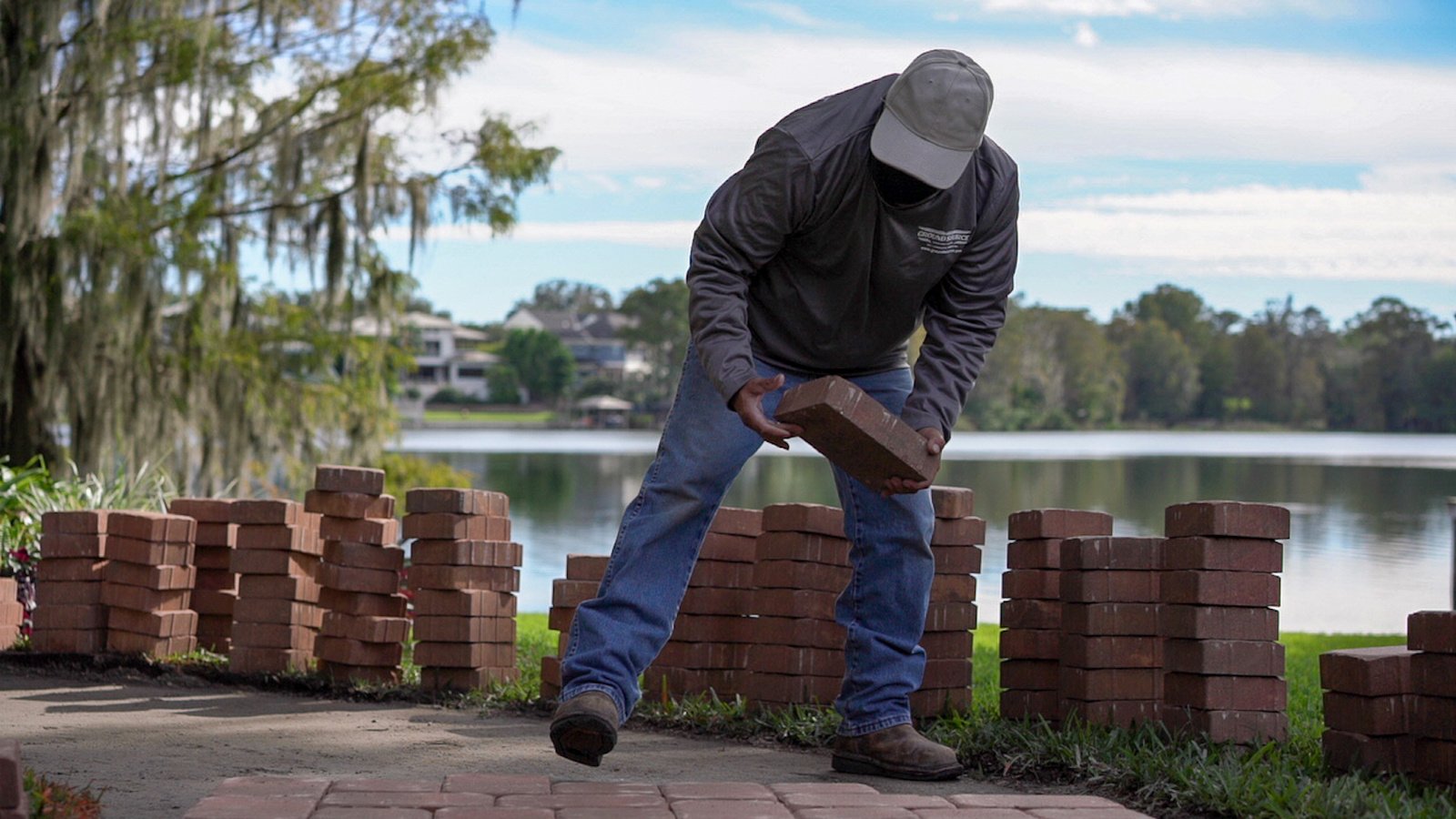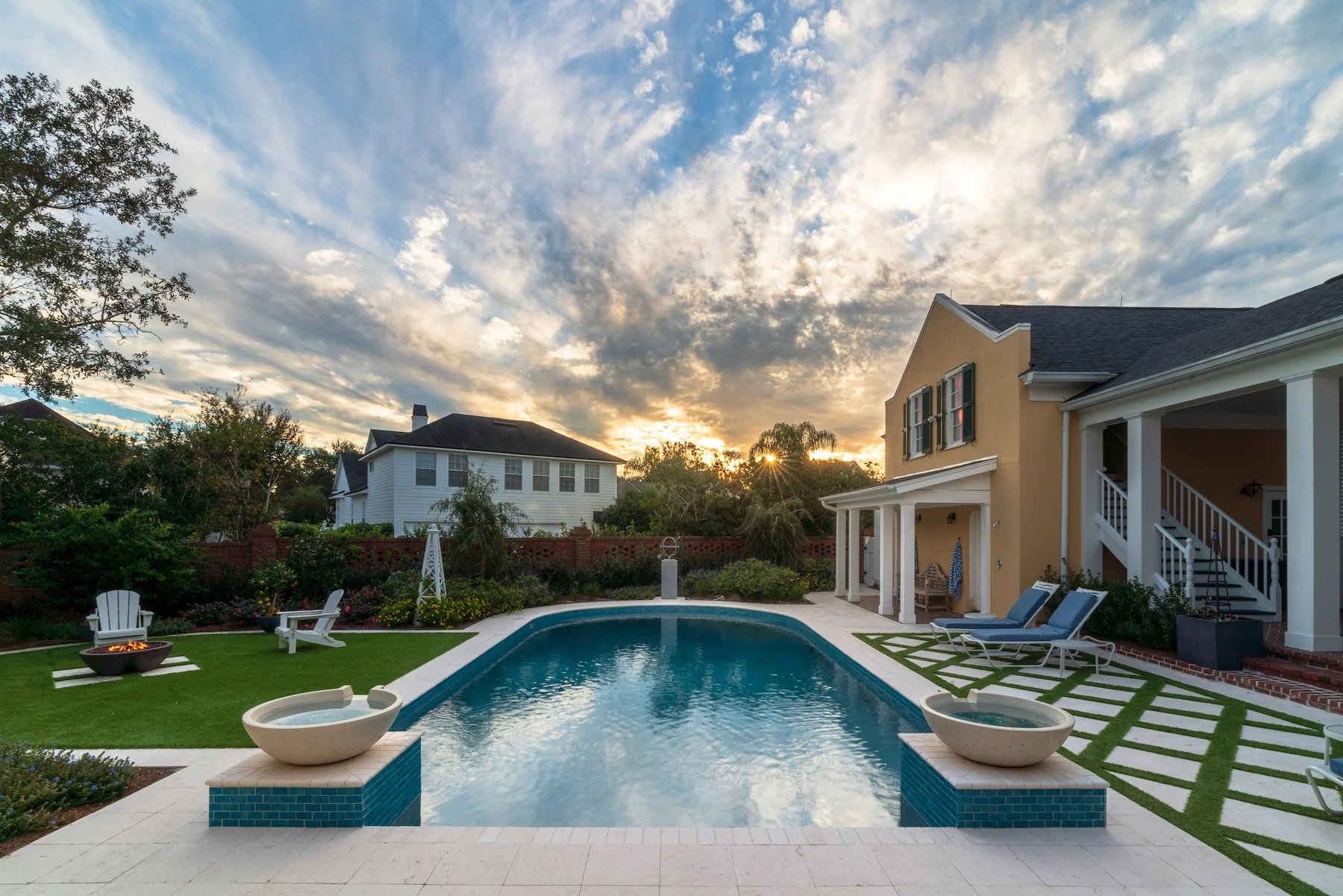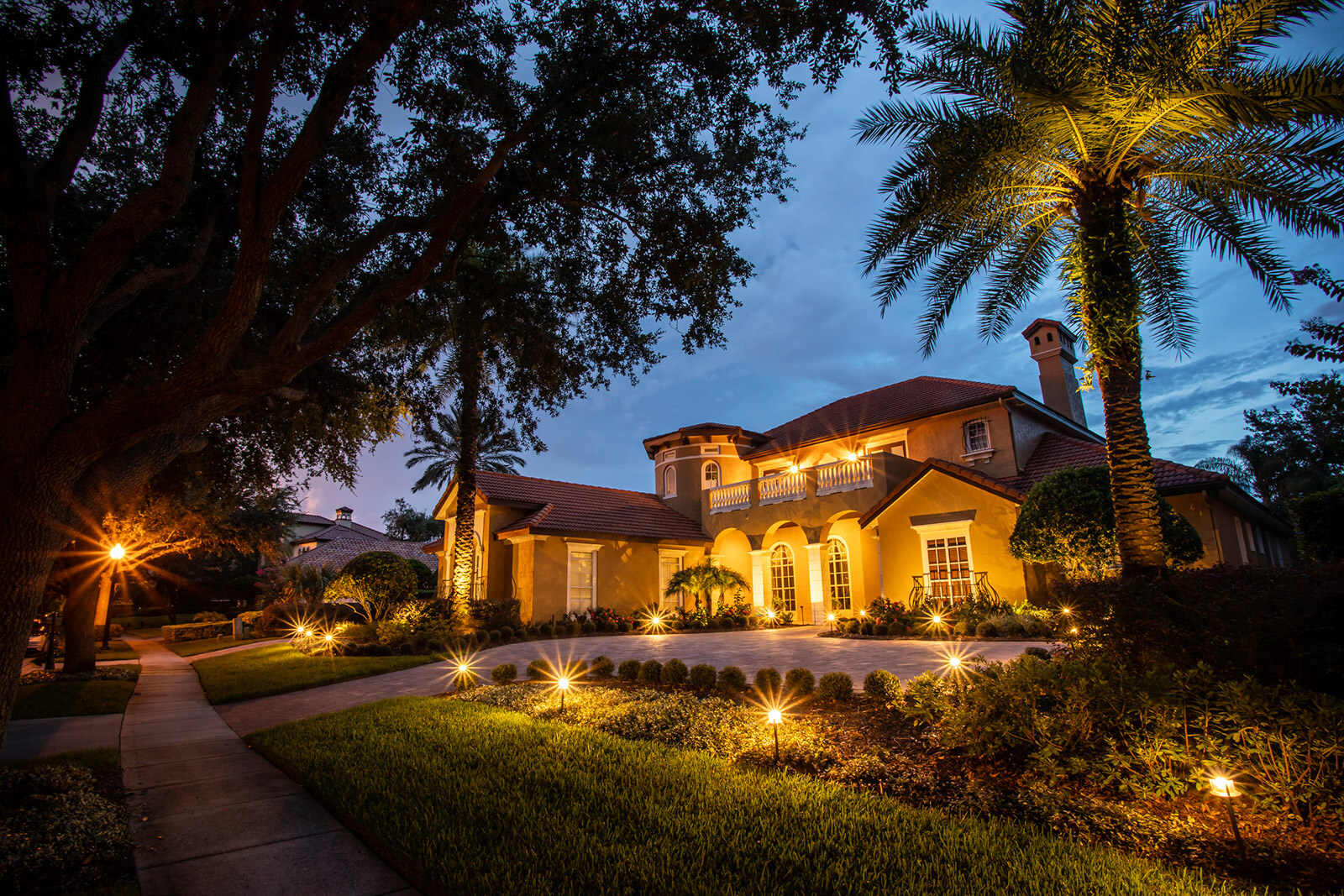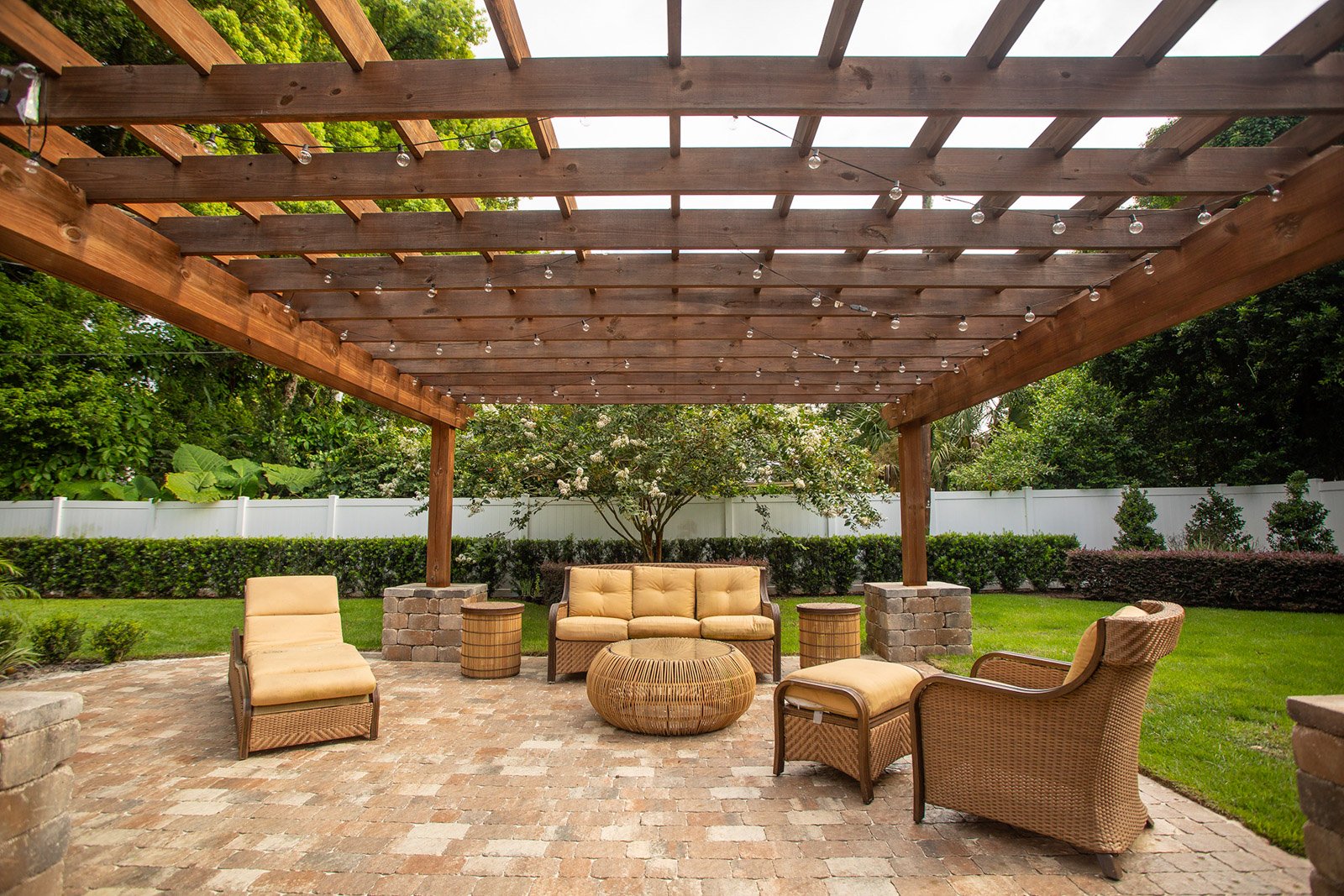Ready for a huge boost in your outdoor life?
A new backyard paver patio changes everything.
It’s the main stage hotspot for your backyard cookouts, your family meetups, your romantic dinners beneath the stars, your boisterous book club hangouts.
It’s where you’ll make toasted marshmallow memories around the fire pit and escape for solace with a bag of snacks after a busy day.
You know you need one. What now?
Grab a snack and dive into your ultimate paver patio guide.
Where to begin? How to find the perfect landscaping partner to pull this off? Or should you tackle it yourself? Once your backyard paver patio is installed, what maintenance does it need? What other fun features will make your paver patio a real outdoor haven?
We’ve got you.
Table of Contents
1. Getting Started: Pondering, Proposals & Picking the Perfect Pro Partner
2. Making Your Patio Part of Your Bigger Outdoor Living Picture
3. From Sand to Sealer: Understanding Paver Construction & Material Choices
4. Your Patio’s Done! Now What? A Peek at Post-Care
5. Alternatives to Concrete Pavers (Why Concrete Pavers Are Your Best Option)
6. DIY Paver Patio Installation vs Working with an Orlando Professional
7. Partner with Orlando Paver Installers Who Make This Easy
Getting Started: Pondering, Proposals & Picking the Perfect Pro Partner
Maybe you’re so excited about your new backyard paver patio that you’ve already invited the neighbors over to have drinks and be jealous.
It’s exciting stuff. But before you throw the fajitas on the grill, there are a few things to tackle.
Here’s a quick look at getting started:
First, Do Some Thinking
What do you want to happen out there? Big family reunions? Or cozy dinners for two? Have you always wanted a fire pit? Dreaming of outdoor movie nights with pajamas and popcorn? Craving a secluded spot for morning meditation?

Jot it all down. Then gather photos for inspiration, from Pinterest or that stack of magazines you’ve been piling. Your landscape designer will appreciate this head-start info as they work to make sure your paver patio design is a perfect fit for your lifestyle.
Next Up, Choose a Landscaping Partner
When you’re shopping for professional paver patio installation, you don’t want just anybody.
Ask some targeted questions to find the perfect pros:
Do they do a lot of hardscape projects, or is this just a thing they do on the side? What do their customers say? Check out their Google reviews.
If a ton of people left reviews and the company also has close to five stars, they’ve made a lot of homeowners happy. Ask about their warranty, and how they stand behind their work.
Make the Most of Your Design Consultation
It’s starting to feel real now, right?
Bring those paver patio ideas you jotted down and your photos. But plan on using the expertise of your designer, too.
A skilled designer will answer all your paver patio questions, from how big your patio should be to what color and patterns will look best with your house.

Pondering a pool patio? A designer can steer you to choices for both beauty and safety. And show you innovative examples to inspire you.
They’ll have samples you can compare to the color of your house, and catalogs packed with design ideas and types of patio pavers.
Your landscape designer will ask you about your budget, so be prepared to be honest and upfront about how much you can spend. Certain features will Increase the cost, from fancy inlay patterns to curves.
Making Your Patio Part of Your Bigger Outdoor Living Picture
A backyard paver patio, sitting out there all by itself, is kind of sad.
Sure, you could stand out there and admire the cool paver pattern and clutch your cold drink. But wouldn’t it be more fun to sit down? Set your drink down? Have a shady respite from the sun? Be surrounded by leafy tropical plants? Maybe gather the family and toast up some gooey s’mores on a cool night?
Paver patio design is way more fun if you add a few cool features to the mix:
Add a Fire Feature
Some people plan a fire pit way out back, so you need an actual stroll to get to the fun. But would you really use it?

Install your fire pit right on your backyard paver patio, a few convenient steps from your door, and there’s no excuse not to use it.
Plan a Pergola
It gets hot out there. Add a pergola to your paver patio design.
It’s an outdoor shade structure with a slatted or lattice-style roof supported by posts. They’re great for covering all or part of your patio, offering a bit of cover from the sun and defining your outdoor space.

Bonus: you can grow vines up the posts, hang plants from the “roof,” and cover the whole thing in twinkling white lights. Suddenly, that patio is where everybody wants to be.
Have Fun with Furniture
Where to sit? Check out these pro tips from Ground Source landscape designer Eric Frisch:
- Buy your patio furniture first, then plan the patio around it. Measure the furniture, whether it’s a petite bistro table for two or a long table with room for all your favorite neighbors.
- When figuring out your paver patio design, allow extra space around the furniture to allow for scooting chairs out and navigating around the furniture.
- Allow for some extra open patio area that isn’t designated for anything, so when you’re entertaining there’s room for temporary extra seating.
Sound too complicated? Opt for built-in seating walls. Boom. Done.
Bring on the Plants
Plants are perfect paver patio partners. (Bonus tongue twister at no extra charge.)
Plants will soften a patio’s hard edges, add shade or privacy, create an appealing border between your patio and your lawn. Add potted plants in big planters to boost the beauty.

Here in Central Florida there are tons of amazing choices, from vivid blue clusters of Lily of the Nile to stunning Copperleaf with its striking leaves of copper, green, pink, yellow, orange, and cream.
But be smart about it. Choose plants that will thrive out there. That means assessing your soil, your light conditions, and how much maintenance you want on your to-do list.
Surround Yourself with Sod
When you’re out there relaxing on your new paver patio, happily surveying your beautiful plants and pondering an evening fire, nothing can wreck the vibe like a weedy, patchy lawn.
A new expanse of lush green sod completes your backyard haven.
Light Up the Night
Don’t leave your great new backyard paver patio in the dark.
Light up that pergola and fire pit. Add overhead bistro lights for a party atmosphere, even if it’s just you out there hiding from dishwasher duty.

Landscape lighting makes safety sense, making walkways, paths, steps and stairs safer.
But it also adds a sense of upscale luxury you’ll love. That stand of foxtail palms next to your patio, when tastefully lit, will knock your sandals off.
So, Your Orlando Paver Installer Should Do More Than Patios
Maybe you’re just thinking of a simple paver patio project.
But you might decide it’s also time for a fresh new sod lawn to surround it. Or a cozy fire pit. Or a shady pergola. Maybe accent lighting to make it all glow after sunset.
You want a full-service landscaping company who can expertly handle it all seamlessly. But not all landscaping companies are full-service landscaping experts.
Look for a creative designer who can help you with the total package and a company with the skills and experience to deliver all your outdoor living needs.
From Sand to Sealer: Understanding Paver Construction & Material Choices
You’ll impress your dinner party guests if you casually toss out, “You know, there’s five inches of crushed concrete fines underneath this patio.”
Once you’ve impressed everybody (or recovered from the awkward silence), you can get back to passing around those grilled jalapeño lime drumsticks.
Here’s a quick and painless look at exactly what materials Orlando paver installers use to create your new backyard paver patio:
Paver Patio Installation: It’s All About That Base
Florida paver patio bases are pretty simple, but that doesn’t mean they’re not important — a properly installed base ensures proper drainage and stability.

A sturdy layer of crushed concrete called “crushed concrete fines,” is installed below your pavers. It’s a recycled concrete aggregate routinely used as a base for pavers, roads, parking areas and building foundations.
The texture of the crushed concrete base beneath your backyard paver patio allows for drainage and helps lock the pavers into place.
Construction crews excavate the area where your patio will go and add several inches of concrete fines on top of the existing soil. Then it’s compacted to make it extra sturdy.
Next Up: Time for Sand
Once your pavers are laid atop your sturdy base of crushed concrete fines, a layer of sand goes over the top and is nestled down in between each paver.

Fine, dry sand, sometimes called “sweeping sand,” is the most common sand used between pavers. But a higher-end option is polymeric sand. It’s an upgrade paver patio layer that costs more, but it helps deter weeds
(More about this in a minute.)
Types of Pavers: You Have a Ton of Choices
Here’s where a skilled patio designer is a huge help, because the types of pavers you can choose from is pretty overwhelming, from classic cobblestone to sleek contemporary slabs to intriguing geometric shapes or pavers with the look and texture of natural stone.
Have fun mixing different patterns and borders to create your own paver patio design.
/office%20display%20multiple%20paver%20patterns.jpg?width=1600&height=1067&name=office%20display%20multiple%20paver%20patterns.jpg)
Order a pallet of its skinny rectangular Empire pavers and you’ll get seven different textures just in one pallet. Used together, they produce a unique sort of crazy quilt design with an artsy, hand-tooled look.
Belgard’s new Papyrus pavers have clean, modern edges with the texture of cloth or handmade paper.
Plan to look down a lot, admiring your artistic new paver patio.
The Right Edging Holds It All Together
Edging is a crucial part of your paver patio, keeping your pavers snugly in place and preventing them from shifting.
Maybe you’ve seen that plastic edging with spikes at the home improvement store. They won’t cut it here in Central Florida, where professional paver patio installation includes concrete molded edging.
The soil is too sandy and soft here for the flimsier stuff. Your pavers would shift all over the place.
Sealing the Deal
Just like it sounds, sealer is the all-important top layer of your paver patio. It locks in the sand between each paver for a tight fit, keeping your pavers in place.

It does all kinds of other cool stuff, too, which we’ll get to in a minute.
Your Patio’s Done! Now What? A Peek at Post-Care
You’re sitting out on your new backyard paver patio, impressing your in-laws with your buffalo chicken dip recipe, and the last thing on your mind is paver maintenance.
Enjoy your dip, but file these tips away for later:
Don’t Skip the Sealer
That sealer we just mentioned? It isn’t a one-time thing. You’ll need to reapply sealer every 2- 5 years.
Don’t skip it. That sealer does way more than look nice. It prevents fading, helps keep weeds from sprouting, protects pavers from weathering, repels stains, and deters pesky ants. (They love building mounds in those sandy spaces between pavers.)
Speaking of Sand…
When Ground Source crews apply new sealer they also touch up and add new sand between pavers first. It’ll seem brand new, which is cool.
Quick pro tip: consider using that polymeric sand we mentioned between your patio pavers during your paver patio installation. It’s an upgrade that costs more, but it really helps deter weeds.
Unlike regular sand, it’s bound with polymers that cause it to harden after it’s swept into the joints and sprayed with water. That makes it tougher for weeds to take root.
Patio Paver Repairs? No Big Deal
One of the great things about patio pavers is they’re pretty sturdy.
Unlike solid slabs of concrete, pavers flex and move as they shift, so they don’t typically crack.

If a paver does get chipped or damaged, it can be replaced. That’s why saving a few pavers from your paver patio installation is a good idea.
Even if tree roots grow underneath and start to push patio pavers up, you can pick them up, remove the offending tree roots, and replace them.
Alternatives to Concrete Pavers (Why Concrete Pavers Are Your Best Option)
Concrete patio pavers aren’t the only game in town when you’re pondering hardscape patio ideas.
How About Poured Concrete?
Maybe poured concrete sounds appealing because it’s cheaper. (More money left for steaks to savor on your new patio.)
Yes, it’s cheaper than patio pavers, but when considering hardscape patio ideas, you should know the drawbacks to poured concrete.

For one thing, it cracks. The sandy soil in our area causes a lot of settling and shifting, which causes concrete to crack.
If trees are near your poured concrete patio, you’re tempting fate. When tree roots grow underneath concrete, they push and lift it, crumbling it into pieces. There’s no way to patch it to look good.
Concrete Patio Pavers Vs. Natural Stone Pavers
Concrete pavers offer many more color and style options and are cheaper than natural stone pavers.
Natural stone pavers look great, but they’re more limiting than concrete pavers. Natural stone like travertine tends to be available in one-size-only options.
Also, natural stone pavers are typically only one inch thick, which is thinner than concrete pavers. That means they’re not ideal for use over a regular paver crushed concrete base since they can easily shift around and settle unevenly.
What About Pea Gravel?
Pea gravel is an option for a more casual patio. It consists of small, smooth, naturally rounded river rocks, each about the size of a pea.
Regarding hardscape patio ideas, pea gravel has its strengths: it’s simple to install, inexpensive, soft underfoot and drains like a dream.

But pea gravel is messy, as the stones can easily spill out of place. Weeds love to sprout in it, which is a big pain. And it’s difficult to keep clean. Leaves and debris get stuck in the gravel and are tough to clean.
Why Patio Pavers Are Your Best Option
When you’re comparing patio pavers vs concrete, natural stone or gravel, pavers come out on top for a lot of reasons:
As we mentioned earlier, pavers flex and move as they shift, which means they don’t crack like poured concrete.
- Tree root troubles? Nope. You can pick up pavers, remove the offending tree roots, and replace the pavers. This also comes in handy if you ever need to run a utility line underneath your patio. You can’t do that with concrete.
- You can’t beat your paver patio design's color, texture, and style choices. Choose pavers that look like rustic slabs, quaint cobblestone, sleek slate. Have fun with contrasting borders.
- When it’s done, it’s done. No waiting, like you have to do with concrete installation. Fire up the grill and set the table.
When it comes to hardscape patio ideas, pavers are the way to go.
DIY Paver Patio Installation vs Working with an Orlando Professional
It would be pretty cool to boast to your neighbor that you installed your own paver patio, right? That guy walks around wearing his tool belt on Saturdays like he hosts a show on HGTV.
Wondering if you should tackle a DIY paver patio or hire professional paver patio installation?

The finished product is the part everybody sees when you’re hosting the neighborhood barbecue or serving margaritas on game day, but some of the most important parts of your backyard paver patio are behind the scenes, to ensure your pavers don’t sink, the color doesn’t fade, weeds don’t sprout, and people don’t trip.
It’s important to get it all just right.
Good Drainage is Crucial
If your backyard paver patio doesn’t drain properly, you have standing water, erosion, foundation damage, or even a wet basement. None of this is good.
Your paver patio should slope away from your house and pitch to the side a bit so water can drain.
The area should look flat and level, but will be installed with just enough tilt for proper drainage. It’s tricky maneuvering.
Heads Up: A Skilled Designer is a Huge Help
Sure, you can figure out how to line up pavers in a straight row. But if you want your backyard paver patio to not just look great, but fit your outdoor lifestyle, hire a landscape designer.
They know the latest types of patio pavers and can suggest the perfect contrasting border.

Even better, they use their skills and experience to help you decide what size and shape backyard paver patio is best for your outdoor living and entertaining needs, so you don’t go too big or too small.
And an experienced, creative hardscape designer will bring wow-worthy ideas that hadn’t even occurred to you. Multi-level with steps? An area just for morning yoga? A built-in seating wall? Hmmm…
Do You Have the Right Tools? (Even a Screed Board?)
If you’re attempting a DIY paver patio, you probably have assorted hand tools hanging around the garage that you’ll need for the job — from a long tape measure to a putty knife to knee pads (have these handy) and a pry bar.
But that’s just the beginning. You’ll need a bunch of specific paver installation tools to get this job done right, including leveling tools, a paver mallet, a masonry chisel, compacting tools and a screed board, that weirdly named essential paver installation tool for making sure your sand base is even as you’re smoothing it out.

That’s a lot of paver installation tools. And a lot of work, from digging and measuring to tamping and sealing. Plus, it makes a big mess.
Why not hire professional paver patio installation?
At Ground Source, we make it easy, from brainstorming ideas at your kitchen table to showing you samples of patio pavers to walking you through the project and keeping you informed.
And we’ll get it right the first time — no worries about sinking, shifting or flooding.
Partner with Orlando Paver Installers Who Make It Easy
You’ve got plenty to think about now:
1. Start pondering your backyard patio life and jot down paver patio ideas.
2. Gather photos of patios and landscaping you love.
3. Find a landscaping partner who answers all your questions with the right answers.
4. Sit down with a creative landscape designer who brings innovative ideas and energy to your patio planning party.
5. Watch the construction process unfold and your new backyard paver patio take shape.
6. Start the grill!
We can’t wait to get started. Save us a burger.
/hardscape%20pavers%20pool%20decking%20with%20palm%20trees%20outdoor%20furniture%20waterfront%20view.jpg?width=1600&height=1067&name=hardscape%20pavers%20pool%20decking%20with%20palm%20trees%20outdoor%20furniture%20waterfront%20view.jpg)
We’re paver patio design experts, but our skills don’t stop there. We’re with you every step of the way as you plan your perfect outdoor space.
Sod, irrigation, landscape design: Let us transform your landscape from an embarrassing eyesore to a place you spend every spare minute.
Are you ready to enjoy the vibrant, impressive landscape you've always wanted? Request a quote today! We’ll help you review your options and then transform your property.






